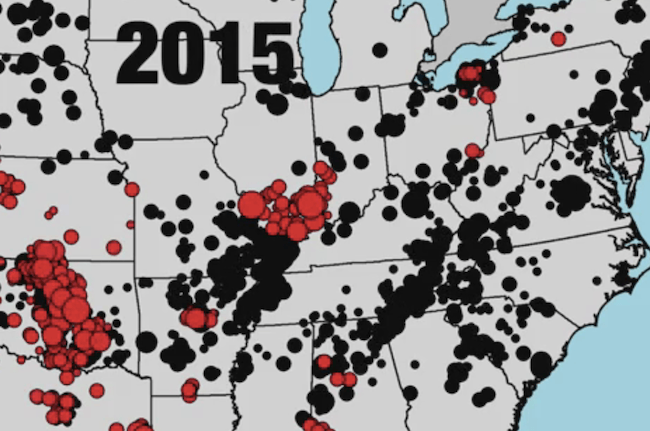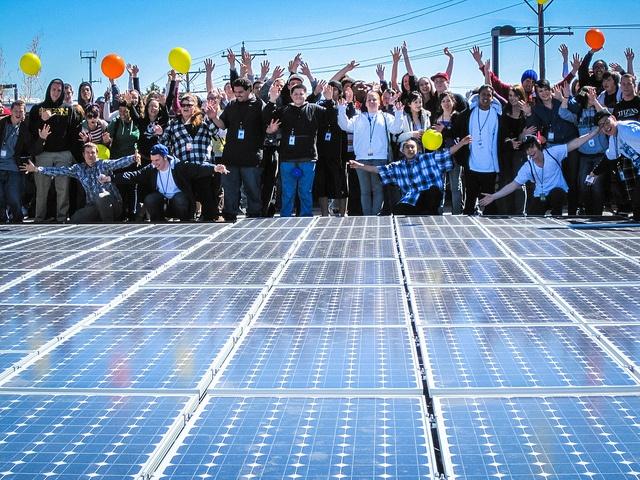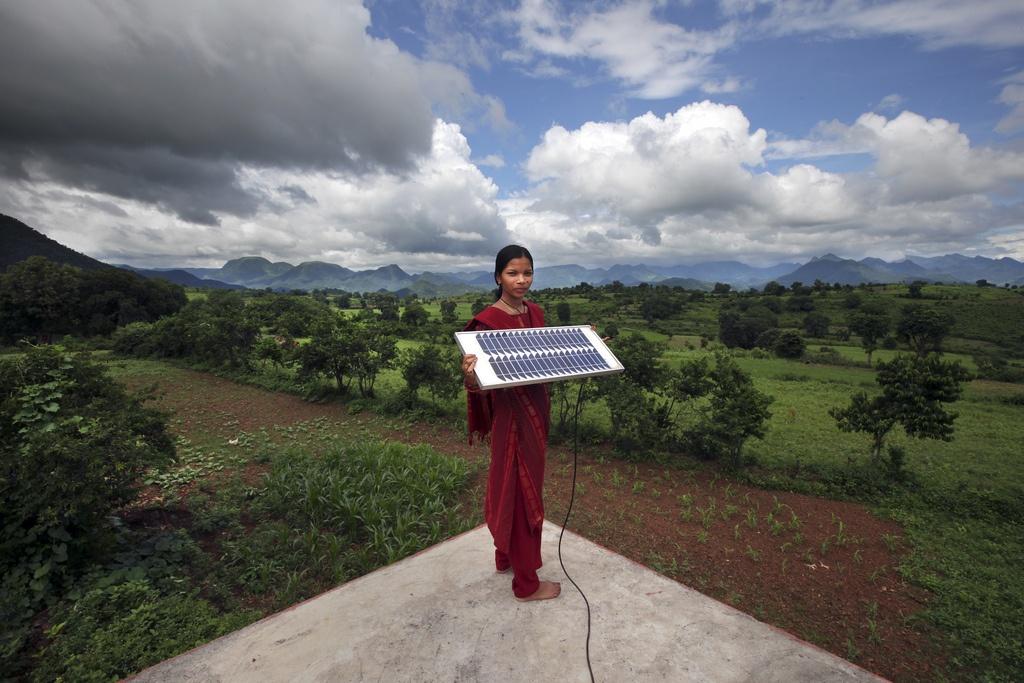New Fracking Studies Sum Up Pope Francis on Climate Change


Advocates for natural gas certainly didn't get much help from Pope Francis last week.
When His Holiness staked out the official Roman Catholic position on climate change in the form of an encyclical titled "Praise be to you, my Lord," he also exposed the messy truth behind the supposedly "clean" fuel that the natural gas industry promotes. That truth has been further underscored by the release of three new fracking studies this month.
1. The new fracking and earthquake study
While natural gas is a relatively clean fuel at the burn point, the widespread emergence of fracking (short for hydrofracturing) raises a host of unsavory lifecycle issues.
Fracking is a drilling method that involves injecting huge quantities of chemical brine deep underground at high pressure, in order to jar oil and/or natural gas loose from shale formations.
Huge quantities of fracking brine come back up to the surface in the form of wastewater, which is typically disposed by injecting it, often at high pressure, into a derelict or unused well.
To a relatively small degree fracking has been linked to earthquakes, among other local impacts. The much more widespread problem is the apparent linkage of earthquakes to injection wells used for fracking wastewater disposal. Evidence has been mounting that confirms the connection, and the latest study appears to be definitive.
The University of Colorado, Boulder is the source for the latest fracking and earthquake study, published last week in the journal Science.
The new study has some serious cred behind it, with the U.S. Geological Survey as a lead partner. Here is the conclusion, as described by lead researcher Matthew Weingarten:
"This is the first study to look at correlations between injection wells and earthquakes on a broad, nearly national scale. We saw an enormous increase in earthquakes associated with these high-rate injection wells, especially since 2009, and we think the evidence is convincing that the earthquakes we are seeing near injection sites are induced by oil and gas activity."
2. Water quality also at risk
So far, the earthquakes linked to fracking wastewater have resulted in little more than property damage -- if you discount the stress and anxiety inflicted on local residents.
Of more tangible concern is the impact on human health, specifically regarding water quality.
The fracking boom of recent years was partly enabled by the creation of a Bush-era loophole in federal clean water regulations, which has allowed oil and gas drillers to keep their fracking ingredients largely secret.
The result has been a patchwork of state regulations and a partial, voluntary disclosure system supported by the industry. The U.S. Environmental Protection Agency (EPA) was charged with a major study of the connection between fracking and water quality, which was just released last month. Considering the lack of complete and consistent data on fracking fluids, the agency came up with a "state of the science" report that pointed out serious gaps in the information chain. The report concluded that significant vulnerabilities exist, but hard evidence of actual impacts is thin.
Industry advocates were cheered by the EPA report, but that was before the latest study on fracking and water quality came out, from the University of Texas, Arlington. According to the study's authors, this is the largest analysis of water quality in aquifers overlying a shale formation in which fracking operations have been occurring.
The study looked at 550 water samples in the Barnett shale formation in Texas over a three-year period. In addition to elevated levels of methanol and ethanol, they found:
"... multiple volatile organic carbon compounds throughout the region, including various 60 alcohols, the BTEX family of compounds [benzene, toluene, ethyl benzene and xylenes], and several chlorinated compounds."
As with most previous studies, this one could not definitively connect the pollution with specific drilling operations. However, the authors point out that many of the compounds are known to be associated with fracking brine, making a strong case for additional monitoring and analysis.
3. Fracking and life
Of the three new studies, the third most clearly underscores the way in which Pope Francis argues for climate action as a reflection of the sanctity of human life.
This new fracking study was released earlier this month by a research team from the University of Pittsburgh under the title, Lower Birth Weight Associated with Proximity of Mother’s Home to Gas Wells.
As with the University of Texas study -- and for that matter, the EPA study -- the Pitt researchers make a clear case that closing the information gap on fracking is imperative.
While the study is on firm ground with the raw numbers linking lower birth weights to geographical location (15,451 babies in three counties from 2007 through 2010), the research team, and the university's media office, have been very careful to note upfront that the causal link has yet to be explored.
Here is the conclusion as described by study co-author, Bruce Pitt:
"Our work is a first for our region and supports previous research linking unconventional gas development and adverse health outcomes. These findings cannot be ignored. There is a clear need for studies in larger populations with better estimates of exposure and more in-depth medical records."
If further studies support the Pitt findings, the results could be devastating for the natural gas industry. The findings are not incremental, but substantial:
"Mothers whose homes fell in the top group for proximity to a high density of such wells were 34 percent more likely to have babies who were 'small for gestational age' than mothers whose homes fell in the bottom 25 percent. Small for gestational age refers to babies whose birth weight ranks them below the smallest 10 percent when compared to their peers."
Taken in consideration of Pope Francis's views on human responsibility for climate change and other lapses in environmental stewardship, it's little wonder that the natural gas industry has pushed back forcefully against Pitt's findings.
The industry-supported website Marcellus Drilling News dismisses the study as "a new anti-drilling-backed so-called 'study' by students at the University of Pittsburgh making wild claims about babies born near Marcellus Shale fracking sites having lower birth weights than those not born near frack sites."
However the natural gas industry tries to short-sell it, the Pitt study does back up a similar 2012 study undertaken by Cornell University, which pulled no punches on the linkage between low birth weight and fracking in Pennsylvania.
The Cornell study looked at single births (as opposed to twins or more) in Pennsylvania, between 2003 and 2010, and demonstrated this result:
"The introduction of drilling increased low birth weight and decreased term birth weight on average among mothers 2.5 kilometers of a well compared to mothers 2.5 kilometers of a future well. Adverse effects were also detected using measures such as small for gestational age and APGAR scores, while no effects on gestation periods were found."
The Cornell research team factored out possible negative effects from water supply and concluded that air pollution or other stress from "localized economic activity" was the cause. Their conclusion:
"These findings suggest that shale gas development poses significant risks to human health and have policy implications for regulation of shale gas development."Another low birth weight fracking study, by a research team comprised of Princeton, Columbia and the Massachusetts Institute Technology, was presented last year at the annual meeting of the American Economic Association, and reached similar conclusions.
It's also worth noting that neighboring state New York banned fracking last year, based on a recommendation by acting Health Commissioner Dr. Howard A. Zucker.
WWPFD?
For some perspective on the position adopted by Marcellus Drilling News, consider that the website's slogan is, "Helping People and Businesses Profit from Northeast Shale Drilling."
Now take a look at the Pope's encyclical (here's that link again). In the English translation provided by the Vatican, the second paragraph lays out the connection between profit and destruction:
"[The earth] now cries out to us because of the harm we have inflicted on her by our irresponsible use and abuse of the goods with which God has endowed her. We have come to see ourselves as her lords and masters, entitled to plunder her at will ..."
As for "what would Pope Francis do" if he were CEO of a drilling company, perhaps His Holiness would at least acknowledge that the latest fracking studies are concerning and worthy of further investigation, rather than dismissing them out of hand.
Image credit (screenshot): Courtesy of University of Colorado-Boulder.
$100 Million for Solar Schools


By Joseph Plummer
If you had $100 million to address climate change, what would you do with it? There are of course plenty of things that need to be addressed when it comes to climate change, and everyone will have different answers to this question. But, given that climate change is a problem that will undoubtedly cost trillions of dollars to address, we can probably accommodate more than a few solution sets.
The National Solar Schools Consortium is doing this exercise right now. The Consortium is a group of organizations that have banded together to accelerate the adoption of solar at schools and universities across the United States. The Solar Foundation has spearheaded the effort, and last year it published the first National Solar Schools Census, documenting the number of schools that have installed systems. This report highlights the 3,752 schools that have already gone solar and analyzes the potential for the rest of the over 120,000 schools in the United States. The Consortium has a bold vision: 20,000 solar schools by the end of the year 2020. So, how do we get there? This is the $100 million question.
How would you tackle this in just over five years? Of the 3,752 solar schools that already exist, about 3,500 of them had their systems installed in the last five years. So, if we continue at that pace with no intervention, we will be at about 7,500 solar schools by 2020. If we consider the growing solar industry and increased financing options for schools, we might be able to anticipate an additional 2,500 solar installations at schools over the next five years -- bringing us to 10,000 (still 10,000 short of of our goal). So, how do we get to 20,000? Is it even feasible?
If someone gave us $100 million, could we make it happen? Let’s pretend we only did small, 1-kilowatt installations that cost $10,000 on average. If we multiply that by 20,000 schools, we find that the total cost of the effort is at least $200 million. And that is if we did small installations. Imagine what the total cost of the effort would be if we attempted to make large installations happen. The question remains: If someone gave us $100 million, could we make it happen?
Yes. If someone gives you $100 million to fund a $1 billion solar schools initiative, you don’t spend the $100 million on installations, at least not entirely. Rather, you spend it on capacity building. One great example of capacity building is the U.S. Green Building Council’s Center for Green Schools. Another great example is the Environmental Defense Fund’s Climate Corps. These programs focus on leveraging a small amount of resources to create massive impact. Using money to leverage more money is a smart strategy, especially when you know you need significantly more money than you have. In the context of solar schools, capacity building might include developing solar school districts, making more financing available to schools, and empowering more school district leaders with the information and training they need to make the right decisions in support of these efforts.
Another way to generate more funds over time would be to create a solar schools endowment that grows from year to year while also funding solar installations at schools. The Virginia Environmental Endowment is a good example of how an endowment can create long-term impact. Another good example of turning a small amount of money into a large amount of money and resources is the Wind for Schools program initiated by the U.S. Department of Energy in 2005. The Department of Energy barely funded the effort, but the universities involved were able to leverage millions of dollars worth of resources.
If you had $100 million to address climate change, what would you do with it? The National Solar Schools Consortium would find a way to get solar installations at 20,000 schools and universities in the United States in less than five years. This is a knightly vision. This vision might seem unrealistic and will most certainly be subject to criticism. But this initiative is what daring greatly looks like. This is the kind of vision we should rally behind. As renewable energy and education communities unite behind the Solar Foundation, we will see that not only can renewable energy engage and inspire students, but it can also inspire a nation. Stay tuned.
Image credit: Flickr/BlackRockSolar
Joseph Plummer is a degree candidate in the Executive Master of Natural Resources (XMNR) program at Virginia Tech, expecting to graduate in May 2016. He currently works for a non-profit organization that works with schools and school districts on renewable energy and sustainability initiatives.
India to Increase Solar Energy Five-Fold by 2022


Indian Prime Minister Narendra Modi gave the nod to increasing the country’s solar capacity five-fold, to a goal of 100 gigawatts by 2022. Currently, the country’s 4.5 GW is no small feat, considering only six nations as of late 2014 surpassed the 5 GW mark, with the U.K. the last country to do so.
India, which is the second largest country in the world with 1.25 billion people, is in good hands with environmental development. Modi, who was elected into office a little more than a year ago, has championed the value of resources and is a proven leader on tackling pressing challenges. He ran for election of the most powerful seat in India on the foundation that he would develop the country by providing solar energy to hundreds of millions of Indians who otherwise would go without electricity.
Bridge to India, a company specializing in the country’s solar market, projects that India will install around 2.7 GW this year, more than solar-driven Germany. After India produces that solar total within the next two quarters, it will firmly place the country in the top five of solar markets globally, joining China, Japan, the U.S. and the U.K.
The environmental progress doesn't come without a pinch in the pursestrings: The 100 GW target is expected to cost around 600,000 crore, an equivalence of a whopping US$100 billion. The cost factors in the expected $4 billion it will take U.S.-based SunEdison to build a solar equipment factory that will contribute 10 GW of solar energy to India over the next seven years.
With such heavy spending, the country faces threatening challenges of debt to complete the anticipated production of 80 GW by 2022. Bridge to India found that it would take nearly $40 billion worth of debt to complete the initiative. While the majority of project funding is planned to come from international lenders like the World Bank, it still raises questions about the project’s legitimacy considering the extreme cost.
However, solar energy is the energy of the future and provides countries with a safe and reusable source of electricity. India, with an alarmingly dense population, struggles to distribute its power equally, especially because of the rising costs of fossil fuel-generated power. This makes solar energy an intriguing option, especially for a country that’s constantly kissed by the sun, like India.
Previously, India had only planned to install 20 GW worth of solar energy by the same target year of 2022. Bridge to India previously estimated that India would reach 31 GW by 2019, but that would only be a fraction of the proposed 100 GW set to be installed just three years later.
The United States just eclipsed 20 GW at the end of last year. The growth of solar in the country has been somewhat exponential -- increasing from 1.2 GW in 2008, former President George W. Bush’s last year in office, to an incredible 21.3 GW today. The increase has been a direct reflection of interest from other countries as well, as China, Germany and now India have all seen enormous spikes of intended solar production within the next few years.
To exemplify just how much 1 GW of solar energy can contribute, the largest coal power plant in the U.S., Plant Bowen in Georgia, is 3.5 GW and has the capability of providing energy to 1.9 million homes in the country. The Nevada landmark Hoover Dam is a 2 GW facility and provides electricity for 350,000 homes.
Global solar installations to are expected to reach 57.4 GW this year, with India paving the way. While India’s progression is certainly an accomplishment to recognize, it may not remain on top of the solar news for long.
China set its own target of 100 GW of solar power, but two years earlier than India. Only six countries have surpassed the 5 GW mark, but it’s unlikely to remain that way for long as solar power is the newest attractive alternative to fossil fuel-generated power.
Image credit: DFID- UK Department for International Development/Flickr
Michigan Good Food Fund Provides Loans to Expand Food Access


Michigan makes you think of cars instead of farms. But the truth is that, rich in biodiversity, the Wolverine State grows some of the best local produce in the U.S. Visit Eastern Market in Detroit, and you will be awed by the state’s bounty. But as in just about every other state, Michigan has its struggles with food access in rural and urban areas alike.
Michigan Good Food Fund, a nonprofit affiliated with Michigan State University, is determined to boost Michigan’s farming sector while increasing food access from the Upper Peninsula to the “thumb” in the southeast part of the state.
As drafted in a 25-point charter last year, the fund is aiming for a holistic approach to have Michigan organizations source more food from within the state. The program seeks to include food and agriculture in the state’s K-12 curriculum while expanding farming opportunities for students. The fund also is pushing for all Michigan institutions to source 20 percent of their food from within the state. In turn, Michigan farmers will supply 20 percent of food purchased in Michigan by 2020. The goals are ambitious, and finance is a big part of this push.
To that end, the program is offering loans to farms and business that can show they'll be part of Michigan’s push to expand food access. Various loan programs for small farmers as well as entrepreneurs will be available. Michigan Good Food is also advocating that state government agencies work together to expand access to financing for farmers. For example, one suggestion is a public-private partnership backing an Agriculture Individual Development Trust Fund, which would help farmers who are just starting out acquire collateral for farm loans.
Although the program’s main focus is to boost local food production by and for Michiganders, Michigan good food has its sights on larger business opportunities as well. Close to large markets in Canada and the Midwest, this program will also push state marketing efforts to include Michigan’s produce in the state’s promotional campaigns.
Despite the state’s potential to become a larger agricultural hub, much work needs to be done. The fund claims 59 percent of the state’s residents lack decent access to retail stores that offer healthy produce, meat and dairy. The organization calls for more food business districts, similar to Grand Rapids Downtown Market and Eastern Market in Detroit, which would attract businesses across the food sector while promoting entrepreneurship. A tougher call for which the fund advocates would be to establish more corner stores selling healthy food, though a business model in Washington, D.C., could offer some insight.
Five years is not much time to transform a state’s agriculture sector, but Michigan’s plan offers ideas for other regions looking for ways to ensure food security and sustainable development.
Image credit: Eastern Market
3 Reasons Why We Love Good360: The Online Donation Matching Network


If you’ve ever experienced nonprofit work from the inside out, you are more than aware of the level of grind required by organizations to make miracles happen from shoestring budgets. Often under-resourced and understaffed, many nonprofits rely on a bevy of donations and in-kind resources to keep the lights on, all the while meeting the needs of the people and communities they serve.
So, when we stumbled across Good360 — a free quasi-social networking site helping nonprofits source donations from companies eager to give — we were immediately inclined to share its unique business model that “works with companies, charities and individuals to make the business of giving simpler, more efficient and more effective.”
According to its mission statement, Good360 works with companies to help nonprofit organizations by matching donations with over 40,000 pre-screened charities. As a result, critically needed in-kind donations are diverted from landfills, and Good360 is able to provide real-time impact data and stories directly to the donating company.
Here are three more reasons why we like this triple-bottom-line business model:
1. Efficiency
No more letter writing, Craigslist digging or labor-intensive GoFundMe campaigns to manage when setting up a profile on Good360 will do. Nonprofits can get back precious staff time and ditch the countless hours spent searching for products or donors to help meet basic needs for the organization. Budgets can also be maximized to spend money where it is needed most and less on things that can easily come secondhand.
Setting up an account is free and seamless. An organization can simply register, create a compelling online profile showcasing the results and direct impact of its work, and develop a wish list, or browse existing available donations.
2. Environmental impact
Re-claiming and repurposing products to keep them out of landfills is a no-brainer. As we think through the donation model of the Good360 platform, companies also have the privilege of rolling out strategic corporate social responsibility plans that adhere to their values through selecting the most appropriate nonprofit partners to provide their donation.
Where diverting previously used or simply excess materials or products responsibly was inefficient, the adoption of a tool like Good360 makes it easier to responsibly dispose of unwanted items in lieu of paying for them to enter the waste stream.
For companies also looking to provide hard data and results to higher-ups and stakeholders, tangible feedback and results are immediately available, reported and shared publicly.
From furniture to office supplies, these highly used and valued products can find a safe home with pre-qualified charities who can also re-submit them to the system if they choose to offload donations to another organization.
3. Community
Good360’s site is just as much an ecosystem for long-term connections as it is an entity bridging the gap for companies and organizations coming together to share resources. Relationships can stem from one small connection and donation that could then lead to additional involvement and investment.
JP Morgan Chase, Gap and Amscan are just a few of the corporate brands that have partnered with Good360. According to an online testimony by Charles Zdrojowy from Tempur Sealy International"
“There are many reasons a partnership with Good360 works for Tempur-Pedic, but by far and away the foremost reason is that Good360 saves Tempur-Pedic the time and energy of ensuring our product is going to fully vetted and qualified recipients. This ensures that the beds that Tempur-Pedic donates go to those truly in need and protects our brand.”
For additional information about the platform and to get involved, visit www.good360.org.
Image credit: Good360
Ford Mexican Manufacturing Plants Are Landfill-Free


Ford Motor Co. achieved zero waste-to-landfill status at its Hermosillo Stamping and Assembly Plant in Mexico, its 16th annual Sustainability report highlights. That achievement makes all of its Mexican manufacturing plants landfill-free.
Achievements at the Mexican manufacturing plants will help Ford achieve its goal of reducing landfill waste globally by 40 percent per vehicle produced from 2011 to 2016. Ford reduced global per-vehicle landfill waste by 40 percent from 2007 to 2011. Since 2013, Ford has reduced per-vehicle landfill waste by 21 percent.
“What makes this noteworthy is that now we can say that all of our Ford of Mexico manufacturing plants are landfill-free,” said John Viera, global director of sustainability and vehicle environmental matters for Ford, during a webinar the company hosted last week.
Ford started reducing landfill waste at its Mexican plants five years ago. Almost 45 tons of cafeteria waste are composted and reused by farmers, solvents are recycled, and scrap aluminum is collected for reuse.
A total of 27 Ford facilities have achieved zero landfill-to-waste status: Thirteen are in North America, seven in Europe, five in Asia Pacific and three in South America.
Hazardous waste is not so easy to reduce
Reducing hazardous waste is proving to be difficult for Ford.
In 2014, its facilities saw an 11.4 percent increase in hazardous waste, and hazardous waste per-vehicle increased by 13 percent since 2013. However, the amount of hazardous waste per vehicle decreased by 10 percent over the last five years.
Ford attributes the increase in hazardous waste to the launch of plants in China and the way China defines regulation of hazardous waste. Ford states that it has chosen to target eliminating “the landfill of hazardous waste first, because this provides the quickest and most cost-effective benefits to human health and the environment.”
How Ford reduces landfill waste
Ford uses a variety of waste reduction technologies and programs to meet its goals. Examples include:
- Ford implemented a minimum quantity lubricant (MQL) machining process to reduce waste by over 80 percent for each engine it produces, in addition to saving water and oil. It has implemented this process at six plants in North America and Europe.
- Five of its U.S. plants send paint sludge to DTE Energy to be recycled and in 2014 this eliminated over 1,300 tons of waste.
- Two of Ford’s plants in China started using a non-landfill treatment method in 2014 for their wastewater treatment sludge that removes 2,800 metric tons of waste from landfill annually.
- Ford has reduced packaging waste in many of its plants, including its Chennai Assembly Plant in India, by using returnable and reusable packaging materials.
- Ford recycles grinding swarf at U.S. and Canadian facilities which eliminated up to three million pounds of waste sent to landfill every year.
Ford acknowledges that its successes, including reducing landfill waste, are part of a journey. Or, as Viera said: “This is a journey. We are not done with the journey. We need to continue making ongoing progress.”
Image credit: Flickr/randychiu
Customer Feedback: That’s Why It’s Called Interactive


By Chet Van Wert
Several years ago, I took part in a project that put the online content of a leading fashion industry publication behind a paid subscription “paywall.” As we built the new user experience in stages, we took the opportunity to interact with readers hitting the new wall: When we told them they had to “subscribe to read more,” we also asked for feedback in a series of short surveys. We were able to capture exactly the information we needed to help maximize conversion.
The one-two punch that let us put this knowledge to work was our ability to capture feedback, formulate a test and implement it quickly – leading to a formula that maximized subscriptions and revenue.
Revenue up, mission accomplished. But this tactical, low-tech effort delivered insights that influenced strategy on a higher level. Our understanding of how various customer segments used our content differently -- for example, Macy’s corporate employees versus thousands of small designers and retailers -- provided enormously valuable direction for marketing and content strategy well beyond pricing.
It's commonplace these days to acknowledge that the customer is in control, especially in the digital, interactive world. So, why don't companies ask for direct customer feedback and run small tactical marketing tests more often? It’s virtually free, simple to execute and, in an important way, what the Internet is all about. That’s why we call it “interactive media,” but it seems that I hear that phrase less often these days.
Digital media give us the ability to iterate marketing concepts, ask consumers questions and get their responses in a rapid-fire rhythm:
- Gather feedback to a quickly-deployed survey
- Create marketing hypotheses and concepts
- Execute marketing test (don’t forget to ask the consumer why they responded the way they did, or didn’t)
Then rinse and repeat:
- Analyze consumer responses
- Create revised hypothesis(es)
- Execute test(s)
Each response-hypothesis-retest cycle can be completed inexpensively in a matter of days or weeks. There are pitfalls, but for the most part they involve your thought process, not the technology or the (negligible) cost. For example:
Pitfall: You gather information that is interesting but isn’t actionable (this happens so much more often than you’d expect).
Antidote: Work backward from information that would have the greatest impact on a specific marketing campaign – value proposition, media choice, messaging or offer – and construct a program that will provide the information you need unambiguously.
Pitfall: You construct your survey so that it will inevitably confirm what you already believe.
Antidote: Instead, try to prove that what you believe is wrong. If you can’t, great! Otherwise, great food for thought.
Pitfall: You ask too many questions, resulting in incomplete answers and losing the consumer’s willingness to respond.
Antidote: Take a disciplined approach to answering one impactful question at a time, or a couple of related questions, and make it easy for the consumer to respond in a few seconds.
Tactical? Yes. Trivial? No way. Do efforts like these take the place of the comprehensive, statistically-validated research we learned about in business school? No, but … traditional research is backward-facing. It assumes you are studying a stable world. In a rapidly changing marketplace, we aren’t trying to paint an exact picture of the status quo. We’re trying to change it, to shape the future.
The one-two punch is the combination of qualitative feedback with quantitative test results. Maybe we’re better off calling this experimentation, not research, but in the haze of battle, what we’re really after is what works. A little thought about the results can often tell us a lot about the “why” that Big Research is after. Is this Truth with a capital T? I don’t know, but I’ll take it.
Image credit: Pixabay
Chet Van Wert is a long-time digital marketer, entrepreneur and intrapreneur. He can be reached at [email protected].
Sustainability & Innovation: Karen Manson, Janssen


At this year’s Sustainable Brands conference in San Diego, we were challenged by Janssen Pharmaceuticals to ask leaders at the conference what the word "innovation" meant to them. Then, more specifically, we asked how innovation may or may not drive advancements in sustainability. We got a terrific range of responses, which we've got documented in a series of short video interviews. You can follow along here.
In this interview, Karen Manson of Janssen gives her answers.
Starbucks steams ahead with extra shot for sustainable coffee farming


Coffee shop giant Starbucks has doubled the size of its Global Farmer Fund program to $50m (£31.5m), as part of the chain's ethical sourcing initiatives to help ensure the sustainability of the specialty coffee industry.
The investment is the continuation of an initial $20m commitment made in 2008, and distributed in collaboration with leading lending organizations such as Root Capital and the Fairtrade Access Fund. To date, the financing has impacted more than 62 cooperatives in 8 countries benefitting more than 40,000 farmers, says the company.
“In 2015, we have achieved a number of milestones across our ethical sourcing initiatives but we know that the work isn’t done. This new investment demonstrates how we remain steadfast in our support of farmers around the world,” said Craig Russell, executive vice president of Global Coffee for Starbucks.
“By providing access to capital, farmers have the ability to make strategic investments in their infrastructure, offering the stability they need to manage ongoing complexities so that there is a future for them and the industry.”
For the full story see the July 2015 issue of Ethical Performance.
Sustainability & Innovation: Len Sauers, Procter & Gamble


At this year's Sustainable Brands conference in San Diego we were challenged by Janssen Pharmaceuticals to ask leaders at the conference what the word "innovation" meant to them. Then, more specifically, we asked how innovation may or may not drive advancements in sustainability. We got a terrific range of responses which we've got documented in a series of short video interviews. You can follow along here.
In this interview, Len Sauers of Procter & Gamble shares his answers: